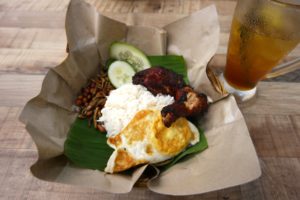
Here now is an introduction to Malaysian cuisine!
Malaysia is one of the most unique places in the world. Given its proximity to other nearby Asian countries both large and small, their tastes in food and traditional dishes all have a fusion of flavors and presentation, along with different ways to enjoy them. Here now is an introduction to Malaysian cuisine!
Food Culture
Let’s start by examining Malaysia’s food culture. For one thing, you should know that the food tends to be strong, spicy, and aromatic and is often considered alongside Chinese cuisine and Indian food as the three main types of cuisine in the country. Preparation is often communal, and neighbors in a village will stir beef rendang or chicken curry. Typically, Malaysian cuisine is eaten using the hands only, without any types of cutlery or silverware. Rice, meat, vegetables, curries, and condiments, such as sambal sauce are the core ingredients of many meals and lunch and dinner are both typically served family-style, where the dishes are placed in the middle of the table for everyone to share.
Favored Ingredients
Seafood is one of the most popular elements of the Malay diet. This includes fish, squids, prawns, and crabs along with chicken, beef, and mutton. Herbs, spices, and stir-fried vegetables are also key ingredients in making Malaysian food what it is. Lemongrass, shallots, ginger, chilies, and garlic are combined into delicious blends sauteed into sambal or chile paste. Galangal, turmeric, makrut lime leaves, laksa, torch ginger, and screwpine leaves are also essential. Also, dried spices are important – such as fennel, coriander, cardamom, cloves, star anise, mustard seeds, cinnamon sticks, fenugreek, and nutmeg. One of Malaysia’s main cities, Malacca, used to be one of the world hubs for spices back in the 15th century, and its reputation has endured into the present era. Coconut milk, known as santan, takes curries (Lemak) to the next level; it’s what makes it so distinctive. Coconut juice is a popular beverage, and old coconuts are grated and turned into traditional Malay cakes.
Various Influences
Now then, let’s talk about influences and variations. Northern Malaysia has leaned into Thai influences because of how many Thai immigrants have entered the culture. Meanwhile, Negri Sembilan influenced by Sumatra tends to incorporate ox meat, beef, veggies, and bird’s eye chilies, which are extremely popular and spicy. South Indian workers, brought in by the British during the colonial period, have contributed to Malaysian cuisine as well. Okra, purple eggplants, brown mustard, fenugreek, and curry leaves are the main ingredients.
Get All Your Asian Groceries at Lotte Plaza Market
Lotte Plaza Market is your one-stop-shop for all of your Korean and Asian grocery needs. With more than 10 locations in Maryland and Virginia, this growing market is always expanding and opening new markets to serve our customers better. Since we opened in 1976, our goal has always been to provide the best customer service and groceries to our customers. For answers to all of your questions, please email us at LottePlaza.com.
